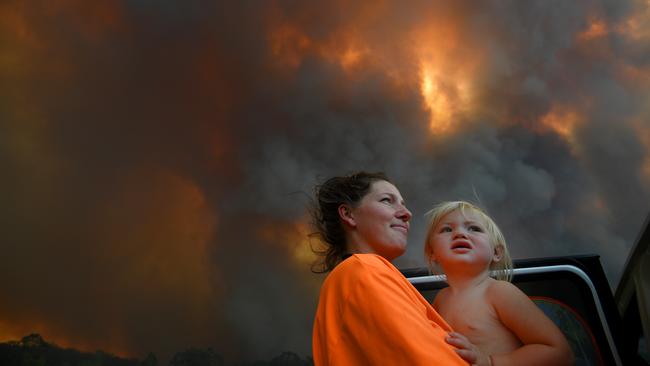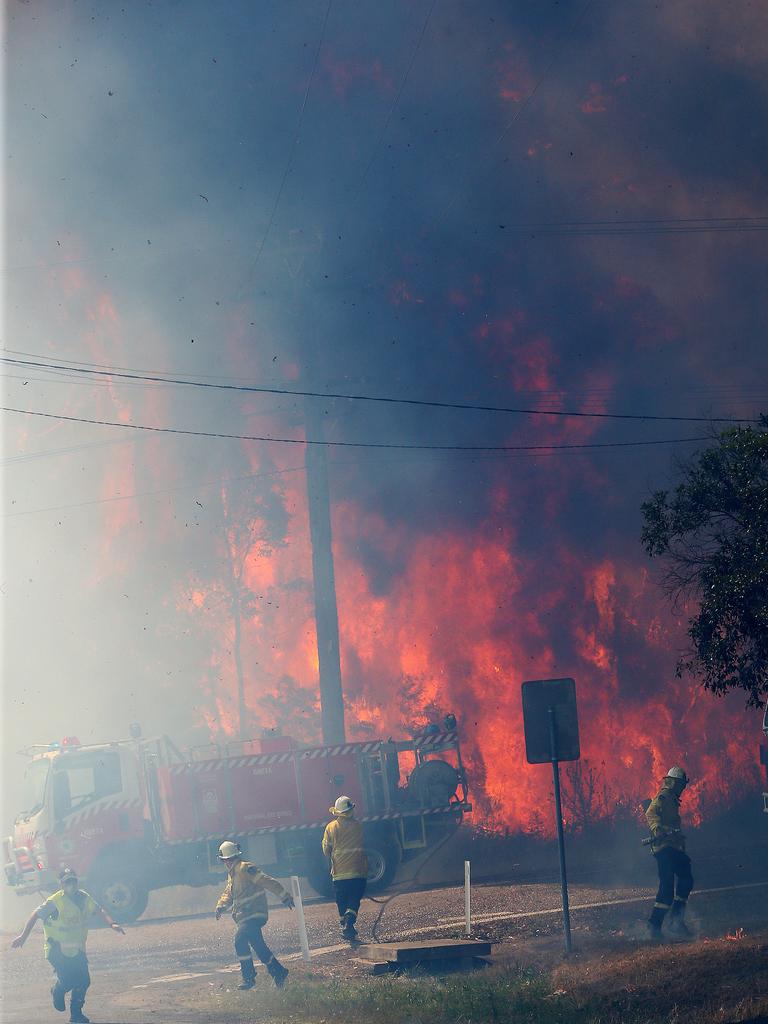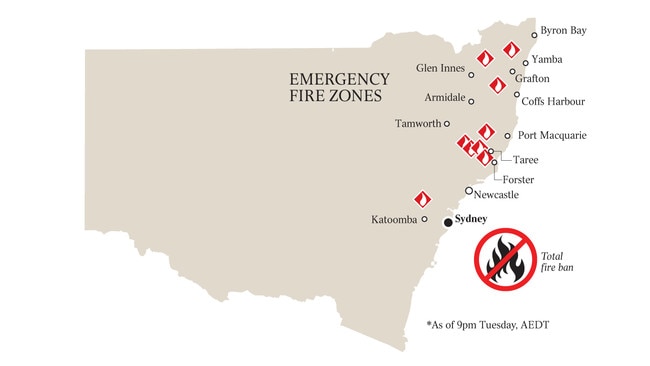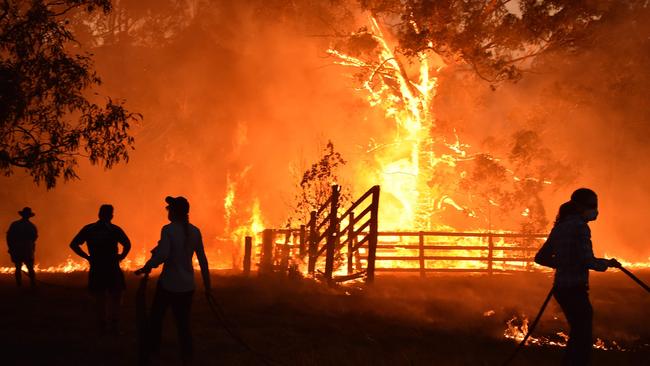The battle to stop million-hectare fire
Authorities warn the fight to tame the biggest firefront in the nation’s history could last months.

The biggest firefront in the nation’s history has burnt out a million hectares of land and scorched the edge of affluent Sydney suburbs, with authorities warning the bushfire battle could go on for months.
Dozens of homes and other structures were damaged or destroyed on Tuesday across northern NSW and southern and central Queensland, as 13 emergency alerts remained current in NSW and authorities continued to urge residents in some areas to evacuate.
READ MORE: Live coverage — new fire fronts break out | After fires, issues to resolve: Kelly | Days now weeks for exhausted heroes | Ill winds reignite menace | Relief as armageddon avoided | Military may be put in firing line | Another blow for face of bushfire crisis | ‘Obnoxious uncle’ Joyce under attack
Several thousand firefighters, including those from interstate and New Zealand volunteers, and about 150 aircraft battled about 130 fires that still threaten dozens of population centres in the two states.
The fierce winds and high temperatures that led to the declaration of a state of emergency in NSW and the first official “catastrophic” fire conditions are expected to move into Queensland on Wednesday.
NSW Rural Fire Service Commissioner Shane Fitzsimmons said the situation remained critical, with existing fires expanding at an alarming rate and new ones starting. “Complacency kills,” Mr Fitzsimmons said. “We cannot afford for people to be complacent. We simply cannot rest easy at this stage.”
He warned that more hot, windy weather was expected later this week and next, and long-term forecasts pointed to a serious challenge all summer.
“It’s going to be a long, difficult fire season,” he said.

Fires sprang up in Sydney’s northern suburbs on Tuesday, sparking a desperate rush to drench houses in South Turramurra with red fire retardant from an aircraft.
Fanned by 80km winds, new fires erupted in the NSW Hunter Valley at Greta and North Rothbury where some homes were damaged or destroyed. On Tuesday night, 78 fires were burning across the state, of which 40 were not contained.
A fire near Coffs Harbour had taken out 150,000ha, Mr Fitzsimmons said, creating a firefront of 1000km.
People in the village of Nana Glen area, northwest of Coffs Harbour, were warned to leave immediately as the Liberation Trail bushfire burned out of control.
Among the major fires in the state’s northeast, Hillville, near Taree, saw at least three structures destroyed. Evacuees at the Taree showground begged loved ones to flee after the NSW RFS issued an emergency alert for the out-of-control bushfire burning across almost 20,000ha.
Taree Show Society president Hans Rooimans said there was an “edgy” atmosphere among evacuees, who had watched as fire tore through Hillville on Friday and again on Tuesday. The Taree region was where one of three fatalities in the fires occurred last week.
A cool change described by Mr Fitzsimmons as a “southerly buster” was expected to move through NSW on Tuesday night but was not necessarily a benefit. It could make fires more unpredictable, and there was no rainfall in the change.
Three men allegedly breached the total fire ban in NSW while a nine-year-old boy admitted to lighting a fire near Wollongong with a blowtorch, according to NSW Police.
In Queensland, 55 blazes continued to rage, the most serious of which were around Yeppoon, the Sunshine Coast, O’Reilly in the Gold Coast hinterland, and south of Stanthorpe in the Granite Belt.
Stanthorpe’s dam is soon expected to run dry, leaving the town short of water to fight fires.

Three thousand firefighters have battled the blazes in NSW, which have burned out an area equivalent to one-seventh the size of Tasmania and four times bigger than all the country burnt through the whole of last fire season.
University of Wollongong bushfire management expert Ross Bradstock said his team had made calculations showing the extent of the latest fires was many times the historical level.
“We are looking at fires five to 10 times bigger in area than those recorded in recent decades,” Professor Bradstock said.
Mr Fitzsimmons said one NSW firefighter had a cardiac arrest and others had been injured.
In NSW four military aircraft joined the fray with soldiers and airmen assisting operations.
Facing the prospect of a long and severe fire season, Defence Minister Linda Reynolds is considering an unprecedented compulsory callout of military reserves to assist with the bushfire emergency, a mechanism of the Defence Act never used.
Mr Fitzsimmons said the combination of drought and high temperatures showed no sign of abating over summer, threatening an extended challenge for months to come. “We really have a long way to go,” he said.
Many fires in the north of the state, including near Tenterfield, Wauchope and Coffs Harbour, expanded on Tuesday.
“If we have bad weather returning, we are not going to be able to get around all these fires,” Mr Fitzsimmons said.
The 13 fires at emergency warning level included blazes in the Hunter, northwest of Newcastle, Taree and surrounds, inland from Port Macquarie and Torrington, north of Glen Innes, near the Queensland border.
Early reports suggested at least 12 homes had been destroyed or damaged in NSW on Tuesday.
Mr Fitzsimmons said that while many residents urged to evacuate early had done so, many had not. But he said it would have been a mistake to use his state of emergency powers granted by Premier Gladys Berejiklian to force people out of their homes.
“You’ve got inherent dangers, challenges and risks associated with forcible evacuations,” he said. “We’ve got very tight, winding roads leading into many of these areas, which is why we talked about leaving early as the safest option. The last thing we want to do is be managing mass evacuations in some pretty difficult-to-access areas, and running the risk of having a whole bunch of congested roadways and seeing people incinerated in their cars.”
Over the border, firefighters battled to contain a massive blaze in eastern Queensland before conditions flare up again.
“We hope to undertake enough action today ... so that tomorrow we have a better success of keeping the fire within the existing lines,” said Rural Fire Service Inspector Wayne Kapernick.
At least 11 homes were destroyed in a 30km-long blaze near Cobraball, Bungundurra, Maryvale and Lake Mary.
Queensland Fire and Emergency Services acting commissioner Mike Wassing said he was comfortable with the status of the state’s largest blazes but containment lines would be tested when the winds shifted. In some parts of the state, pineapple growers were desperately trying to harvest their crops before the fires hit.
Additional reporting: Emily Ritchie, AAP






To join the conversation, please log in. Don't have an account? Register
Join the conversation, you are commenting as Logout